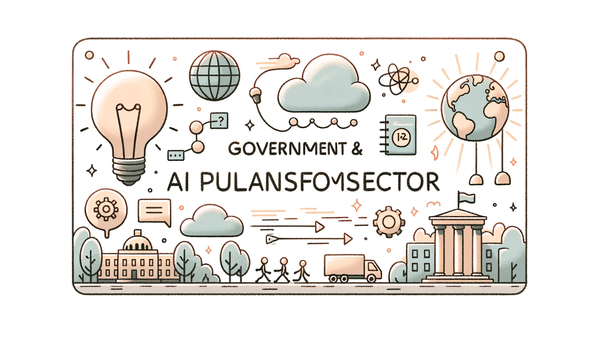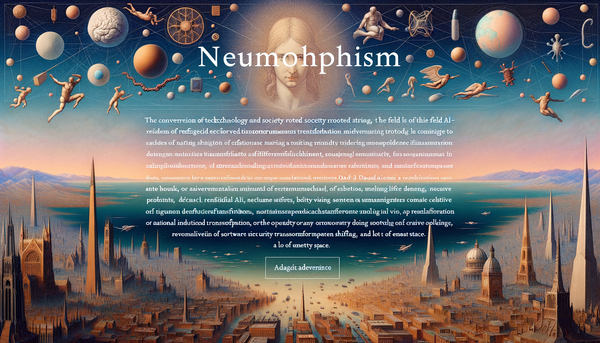El Salvador's AI Investment and Innovations

AI's relentless march reshapes industries and societies alike, as witnessed by breakthroughs at global events, strategic political investments, revolutionary renewable energy integrations, and emergent security challenges that insist on a more thoughtful, secure path forward.
Revolutionizing the Tech Industry: From Development to Deployment
The pace of technological innovation has never been as captivating as it is today. At MWC 2025, GIGABYTE stunned audiences by unveiling a comprehensive AI computing portfolio that not only pushes the boundaries of hardware performance but also redefines the entire lifecycle from research and development to deployment. This transformative approach underscores the growing importance of integrating AI capabilities directly into computing platforms—ushering in an era where development and deployment are no longer distinct phases but parts of an interconnected ecosystem.
Industry experts have long noted that AI does not simply serve as an add-on but is becoming the bedrock of modern technology. The showcased portfolio reflects a strategy where AI-enabled acceleration is prioritized, and computational architectures are reimagined for efficiency and scalability. Observers recall the words of Mark Zuckerberg, who once noted,
“AI is one of the most important fields of technology, because it has the potential to automate thinking itself, which is something we've never been able to do before.”
Such a vision is no longer a distant dream but a daily reality for companies reinventing their operational paradigms.
The shift toward AI-centric computing is echoed in various discussions on our AI.Biz website where advancements continuously alter the technological landscape. The convergence of hardware innovation and AI highlights a new chapter in technological transformation—one that is as exciting as it is fraught with challenges and opportunities.
Shaping the Future Through Strategic Investment and Policy
Not all technological revolutions can be compelled solely by advancements in labs and factories; sometimes, it takes visionary political and financial leadership to set the stage for massive change. In a high-profile demonstration of this dual role, El Salvador’s President Nayib Bukele met with Andreessen Horowitz co-founders Ben Horowitz and Marc Andreessen to discuss a future imbued with tech investments and innovative policies. This gambit sees the nation not just riding the wave of existing tech trends, but actively shaping its future by proposing a visionary 0% tax rate for tech industries.
This meeting, held at Casa Presidencial, was more than a formal exchange—it was an invitation for global innovators to reimagine El Salvador as a tech hub. With a storied past that includes pioneering Bitcoin adoption, the country now sets its eyes on embracing artificial intelligence as a cornerstone of economic development. The focus on both Open Source and proprietary AI models propels forward new pathways in cost reduction and market entry strategies.
Education, inevitably, becomes the bedrock of such futuristic economies. Leaders stressed that the successful adoption of AI and tech would require a parallel emphasis on robust training and knowledge dissemination, ensuring that local talent can support and sustain technological growth. As noted in several reports on our website, including our analysis on how AI lives in security education and innovation, bridging the gap between policy and practice is essential for cultivating a thriving tech ecosystem.
This strategic investment into technology isn’t merely a financial decision but an ideological shift—a recognition that in the coming years, the machinery of economic development must be powered by code, innovation, and a willingness to embrace change. Observers might recall B.F. Skinner’s old adage,
“The real challenge is not whether machines think but whether men do.”
In this light, policymakers are urged to think creatively and adapt swiftly.
Integrating AI with Renewable Energy and New Economic Models
The transformation stemming from AI is not confined to computing or enterprise; it is also seeping into other realms such as renewable energy. Forbes’ exploration of “Wave Power and AI” illustrates the innovative intersection between natural energy sources and artificial intelligence. In this context, AI not only optimizes energy production and grid management but also pioneers sustainable practices that increase efficiency and reduce waste.
Imagine a future where sensor networks and intelligent algorithms adjust the behavior of wave power installations dynamically, optimizing power output according to environmental conditions. This synergy could lead to smarter, more adaptive renewable energy systems that are both economically viable and environmentally friendly.
Moreover, the concept of AI agents establishing their own economy—an idea highlighted in multiple narratives on Decrypt—introduces a fascinating new dimension into the digital economy. When AI-driven entities begin to negotiate, transact, and self-organize, the conventional boundaries of labor, markets, and even currency might blur into a seamless digital marketplace. The economic implications of such a shift are profound. As automated processes and AI agents collaborate without direct human intervention, we might witness the emergence of entirely new business models, where efficiency and scalability reach heights formerly unimaginable.
Experiments in decentralized finance and blockchain-based autonomy may someday intersect with AI's inherent capabilities, leading to scenarios where digital agents independently drive economic decisions and market adjustments. Such a shift requires careful thought about regulation, security, and the ethics of artificial autonomy. However, it also promises a world where economic activities speed up, operational costs plummet, and global markets become more accessible, even to players operating on micro scales.
Notably, this expanding horizon aligns with trends we detail on our concerns over AI trade insights and the evolving landscape of market dynamics. The dual narratives of innovation and caution continue to steer AI towards both promising breakthroughs and pressing existential questions.
Securing the Future: Lessons from AI Training Datasets Gone Wrong
As exciting as these technological feats are, they come with significant challenges—especially around security. A revelatory investigation by Truffle Security, detailed by BleepingComputer, uncovered nearly 12,000 valid API keys and passwords embedded in the Common Crawl dataset, a crucial source for AI training data. This incident marks a warning bell about the intersection of large-scale data utilization and inadvertent security lapses.
Embedded within hundreds of terabytes of openly available web data were keys to services like Amazon Web Services and MailChimp, hidden in plain sight within HTML and JavaScript. The magnified risk isn’t just the exposure itself but the cascading effect it could have on projects built atop compromised data. When these keys reappear across multiple sites—63% reuse rates and certain API keys appearing tens of thousands of times—one is forced to grapple with a disturbing reality: the conveniences of large-scale open data must be tempered with robust security practices.
This revelation is particularly resonant in today’s integrated AI narratives. As companies race to deploy new AI models without comprehensive security checks, the implications could be disastrous. Developers are now compelled to reexamine their data sourcing strategies and prioritize secure coding practices. In an era where even a single mistake can lead to widespread vulnerabilities exploitable by malicious actors, the need for intensified awareness is paramount.
Our content on cybersecurity innovations sheds light on related vulnerabilities that echo this discovery. This is a clarion call for a deeper integration of security measures in every step of the AI development lifecycle—from pre-processing large datasets to deploying models that could inadvertently expose sensitive information.
Here, we are reminded of the timeless adage with a modern twist: "People fear what they don't understand." In the realm of AI, where the interplay between data volume and vulnerability is constantly evolving, understanding and mitigating risk has never been more critical.
AI and the Fabric of Society: Toward a Unified European Identity
Beyond the technical marvels and the security hurdles lies a quieter revolution—one that intertwines with the cultural and social fabric of societies. An intriguing contemplation from RFI English asks, “Could European AI create a more unified European identity?” This inquiry delves deep into how AI may transcend its utility as a mere tool and instead become a catalyst for fostering a sense of shared identity and purpose.
By leveraging multilingual data and inclusive design principles, European AI initiatives aim to bridge linguistic and cultural divides. The potential to create smart systems that reflect local nuances while simultaneously harmonizing with a pan-European ethos is a unique experiment in technology-fueled social integration. In today’s diverse multicultural landscape, AI could serve as a medium for dialogue, understanding, and even reconciliation.
Such a vision relies heavily on the concerted effort of policymakers, technologists, and cultural institutions working side by side to ensure that the algorithms driving this change are as inclusive as they are innovative. When digital technologies begin to mirror the complexities of human identity, they bring with them not just efficiency but also a profound opportunity to build societies that are collectively smarter and more empathetic.
This is a narrative that resonates well with our broader discussions on AI’s role in societal development. Whether it's in shaping security paradigms, fostering economic autonomy, or even crafting a unified cultural identity, AI continues to be a transformative force that invites us to reimagine the very foundations of community and collaboration.
Navigating the Road Ahead: Integration, Innovation, and Responsibility
What emerges from these multifaceted explorations is a landscape where technology, policy, and culture converge into a singular, pulsating force—the force of innovation driven by artificial intelligence. Across our review, we see a tapestry of stories: from GIGABYTE’s transformative portfolio and El Salvador’s audacious tech initiatives to the nuanced interplay between security pitfalls and cultural unity. Each narrative adds a unique thread to the broader fabric of AI’s impact on today’s world.
This integration calls not only for smart engineering but also for thoughtful leadership. The drive for advancements must be matched with an equally robust commitment to responsibility. For instance, while AI agents forming their own economies promise unparalleled efficiencies and new avenues of commerce, this same promise brings regulatory, ethical, and social concerns that must be addressed before we fully embrace such a paradigm.
Historical analogies abound as industries have repeatedly faced similar crossroads. Much like the industrial revolution required new economic policies and labor regulations to harness technological benefits safely, the current AI revolution demands that we craft intelligent guidelines. These strategies should encourage innovation while safeguarding against potential abuses, ensuring that all participants—from large conglomerates to small start-ups—navigate this new terrain with confidence and security.
In many ways, the AI evolution mirrors past transitions in technology. There is an inherent tension between breaking new ground and preserving established systems. Yet, if navigated correctly, the outcome will be a more agile, secure, and inclusive ecosystem. The path ahead is illuminated by lessons drawn from events such as the recent policy innovations in El Salvador, the technological showcase by GIGABYTE, and comprehensive debates surrounding data security. Each contributes to a collective wisdom that urges us to innovate while remaining vigilant.
At its core, the future of AI isn’t just about displacing old norms—it’s about building on them. It’s about recognizing that, as B.F. Skinner wisely observed decades ago, the real challenge lies not in creating thinking machines, but in challenging ourselves to think differently. This spirit of innovation, blended with a deep sense of responsibility, promises a future where technology serves as a bridge to a better, more connected society.
Further Readings
- AI Lives Security Education Innovation – Exploring AI's Role in Securing Our Digital Future
- Concerns on AI Trade and Market Insights – A Closer Look at Financial Impacts
- Latest Trends in AI and Cybersecurity – Understanding the Balancing Act
- NetSuite’s Expansion into AI-Driven Intelligent Solutions – The Future of Business Software




